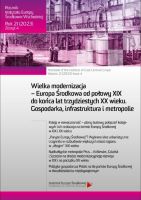Arystokracja i jej wpływ na modernizację gospodarczą Śląska Austriackiego i północno-wschodnich Moraw przed 1848 r.
Aristocracy and its influence on economic modernization of Austrian Silesia and northeastern Moravia before 1848
Author(s): Aleš ZářickýSubject(s): Cultural history, National Economy, Social history, Sociology of Culture, Economic development, 19th Century
Published by: Instytut Europy Środkowej
Keywords: Industry; Mining; Metallurgy; Economy; Austrian Silesia;
Summary/Abstract: After losing the austrian legacy wars and losing a crucial part of economically advanced Silesia to Prussia, the Austrian state initiated economic modernization of the rest of the country through financial incentives as well as its own investments. In addition to traditional agriculture and forestry, states’ support activities focused primarily on the development of the textile industry and the resumption of ore mining, and later also on stone coal. While textiles became the domain of members of the old craftfamilies, and above all of the representatives of the fledgling bourgeoisie recruited from the ranks of merchants and final treatments of fabrics and textile goods, it was the land nobility who played a decisive role in the heavy and extractive industries. While these industries developed more slowly than textiles after the country was divided, they gradually strengthened their role within the country‘s economy from the end of the 18th century until, in the second half of the 19th century, it became a crucial and dominant segment of industrial production in the region under review, despite the dynamic development of textile production that continued throughout the habsburg monarchy.
Journal: Rocznik Instytutu Europy Środkowo-Wschodniej
- Issue Year: 21/2023
- Issue No: 4
- Page Range: 7-38
- Page Count: 32
- Language: Polish

